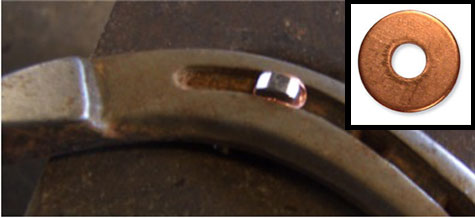
Do you have a shoe that’s perfectly fine, but the nail holes are worn out?
You really don’t want to increase the nail size. And, you certainly don’t want to toss a shoe that’s otherwise still serviceable, especially one that you’ve invested plenty of time, sweat and elbow grease into making at the anvil.
“I was hand-making Scotch bottom draft horse shoes,” Steve Kraus told attendees at the 2014 International Hoof-Care Summit in Cincinnati. “These were half-inch thick, big, heavy shoes. I made them all by hand because I was shoeing a lot of heavy show hitch horses. As the nail holes get worn out, the shoe is still good. These shoes never wear out. So, why do I want to throw away this expensive shoe that I spent all of this time making?”
The head of Farrier Services at Cornell University found a $12 box of size 8 copper rivet burrs — just like the rivets you use to put pads on — and tried a little experiment.
“I put these little copper washers on the nails and I drove them in,” Kraus recalls. “They sleeve right around the head. It’s just like a little bushing. The rivet burr will fold up right around the head. It’s quick and easy to do. Now I don’t have to upsize the nail. Or once they get past size 10, I can’t upsize the nail; the head doesn’t get larger past size 10.”
A size 8 rivet burr can be used with a #8-10 regular head nail. While a size 12 washer will work with smaller nails such as a #5 city head or a #5 slim blade. The copper burrs also can be used on hand-forged gaited shoes, he says.
“You buy a pound of them and you’ll have them forever,” Kraus says. “You’re not going to use a lot of them.”

Steve Kraus, head of Farrier Services at Cornell University, uses a size 8 copper rivet burr, inset, with a #5 slim blade horseshoe nail when the holes wear out but the shoe is still usable.








Post a comment
Report Abusive Comment